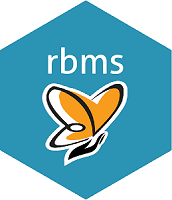
With rbms, we aim to facilitate the implementation of statistical and mathematical methods developed for computing relative abundance indices from yearly time series of butterfly counts. These data are characterised by temporal patterns (phenology) that must be accounted for when deriving abundance from a time series of counts. As a toolbox, we plan to implement more methods to compute and visualise metrics as they develop. The rbms package will provide the option of being coupled and working in line with other tools available and developed by the community (e.g., rtrim, BRCindicators). With the development of the ‘rbms’ R package, we also provide a tutorial to facilitate its usage and understanding.
Although rbms implements methods that were developed independently and for which the source should be acknowledged, users should also cite the rbms package and its version to ensure good referencing and improve the reproducibility of the work.
Suggested citation for the rbms package
Schmucki R., Harrower C.A., Dennis E.B. (2024) rbms: Computing generalised abundance indices for butterfly monitoring count data. R package version 1.2.0. https://github.com/RetoSchmucki/rbms”
The rbms package implements methods from:
- Dennis, E.B., Freeman, S.N., Brereton, T., Roy, D.B., 2013. Indexing butterfly abundance whilst accounting for missing counts and variability in seasonal patterns. Methods Ecol Evol 4, 637–645. https://doi.org/10.1111/2041-210X.12053
- Dennis, E.B., Morgan, B.J.T., Freeman, S.N., Brereton, T.M., Roy, D.B., 2016. A generalized abundance index for seasonal invertebrates. Biom 72, 1305–1314. https://doi.org/10.1111/biom.12506
- Schmucki, R., Pe’er, G., Roy, D.B., Stefanescu, C., Van Swaay, C.A.M., Oliver, T.H., Kuussaari, M., Van Strien, A.J., Ries, L., Settele, J., Musche, M., Carnicer, J., Schweiger, O., Brereton, T.M., Harpke, A., Heliölä, J., Kühn, E., Julliard, R., 2016. A regionally informed abundance index for supporting integrative analyses across butterfly monitoring schemes. J Appl Ecol 53, 501–510. https://doi.org/10.1111/1365-2664.12561
Installation
Once the R programming system is successfully installed, you can install the rbms package from GitHub. For this you will need to install the package devtools or remotes, both available on CRAN. Once installed, use the function devtools::install_github() to install the rbms package on your system.
Note that
rbmsis built with R > 3.6.0, so you might need to update your R system before installation. To install devtools on Windows system, you will also need to install Rtools - note Rtools40 for R 4.x.x New toRor want to refresh your R coding skills, try the excellent tutorials available at ourcodingclub 👍
if(!requireNamespace("devtools")) install.packages("devtools")
devtools::install_github("RetoSchmucki/rbms")Get Started
Consult the tutorial vignettes / Articles to learn about rbms data format and the workflow how to compute flight curves, abundance indices, and collated index with a bootstrap confidence interval
Further documentation is also available through the help function in R or from the rbms online references
Development
Since version v.1.1.0, rbms is likely to perform better with species having sparse data, potentially resulting in more flight curves and indices being computed. This version implements a basic plot method for “pheno_curve”, using the object produced by the flight_curve() function as an argument.
# usage or plot method
library(rbms)
data(m_visit)
data(m_count)
ts_date <- rbms::ts_dwmy_table(InitYear = 2000, LastYear = 2003, WeekDay1 = 'monday')
ts_season <- rbms::ts_monit_season(ts_date,
StartMonth = 4,
EndMonth = 9,
StartDay = 1,
EndDay = NULL,
CompltSeason = TRUE,
Anchor = TRUE,
AnchorLength = 2,
AnchorLag = 2,
TimeUnit = 'w')
ts_season_visit <- rbms::ts_monit_site(ts_season, m_visit)
ts_season_count <- rbms::ts_monit_count_site(ts_season_visit, m_count, sp = 2)
ts_flight_curve <- rbms::flight_curve(ts_season_count,
NbrSample = 300,
MinVisit = 5,
MinOccur = 3,
MinNbrSite = 5,
MaxTrial = 4,
GamFamily = 'nb',
SpeedGam = FALSE,
CompltSeason = TRUE,
SelectYear = NULL,
TimeUnit = 'w')
## Flight curves are in the "pheno" data.table located within the ts_flight_curve result is a list
str(ts_flight_curve$pheno)
## Basic plot method to plot flight curve
plot(ts_flight_curve)
points(ts_flight_curve, col = 'magenta', pch = 19)
# for a single or multiple years
plot(ts_flight_curve, year = c(2001, 2002))
points(ts_flight_curve, year = 2001, col = 'magenta', pch = 19)
# for multiple year curves overlapping on a base year, use the argument BaseYear
plot(ts_flight_curve, year = 2000, SiteID = 1, col = 'dodgerblue4')
points(ts_flight_curve, year = 2002, SiteID = 1, BaseYear = 2000, type = 'l', col = 'cyan4')
points(ts_flight_curve, year = 2001, SiteID = 1, BaseYear = 2000, type = 'l', col = 'orange')
legend("topright", legend = c("2000", "2001", "2002"),
col = c("dodgerblue4", "cyan4", "orange"), lty = 1,
box.lty=0)
# multiple year curves on a time series with different portions per year, use xlim
plot(ts_flight_curve, year = c(2000), xlim = as.Date(c("2000-01-01", "2002-12-30"), format = "%Y-%m-%d"), SiteID = 1, col = 'dodgerblue4')
points(ts_flight_curve, year = 2001, SiteID = 1, type = 'l', col = 'cyan4')
points(ts_flight_curve, year = 2002, SiteID = 1, type = 'l', col = 'orange')
legend("topright", legend = c("2000", "2001", "2002"),
col = c("dodgerblue4", "cyan4", "orange"), lty = 1,
box.lty=0)Reporting Issues
For reporting issues related to this package or workflow, please visit the issue and before opening a new one, see if your problem is not already in the list reported issues here